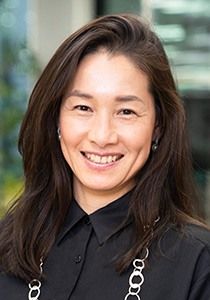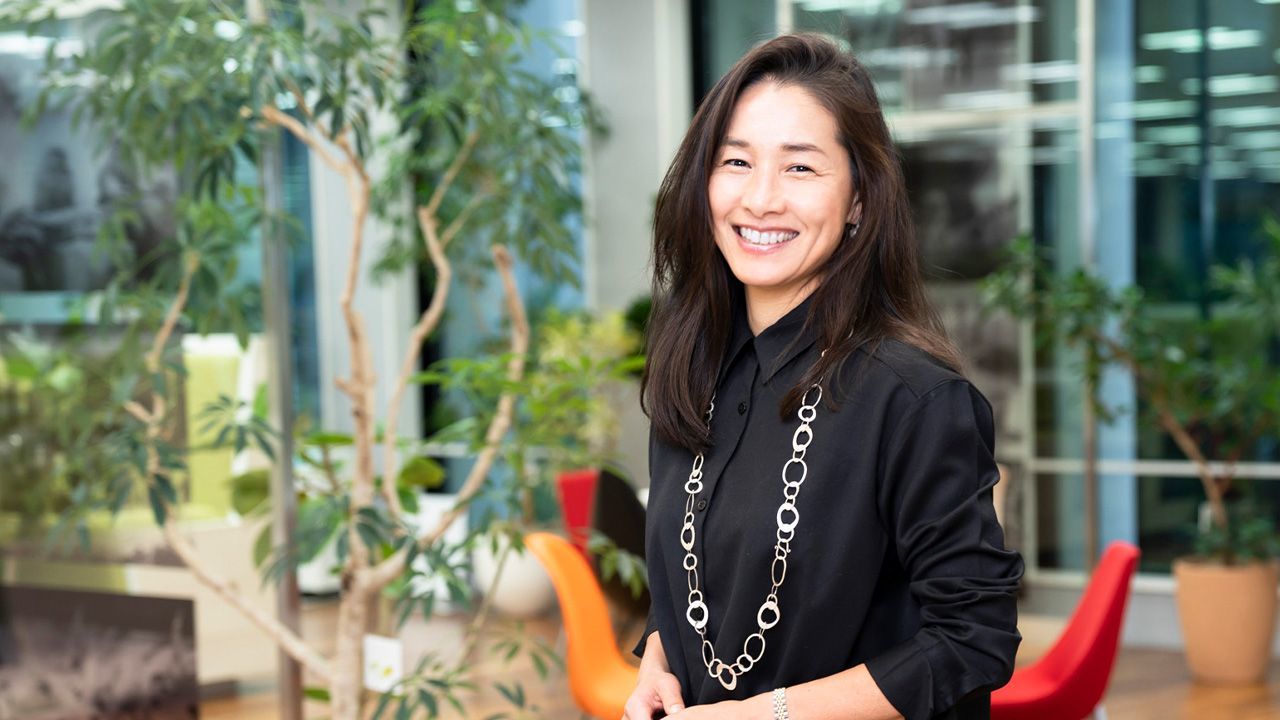
Tennis Great Date Kimiko Helping Bring Japan’s Tennis Courts in from the Cold
Sports- English
- 日本語
- 简体字
- 繁體字
- Français
- Español
- العربية
- Русский
In Japanese tennis circles, the term “made in Japan” is bandied about in reference to certain competitors. In reality, though, most of the country’s top players competing at Grand Slam events, stars like Ōsaka Naomi, Nishikori Kei, Nishioka Yoshihito, and Daniel Tarō, are products of tennis academies overseas. This situation has deepened the long-held desire of tennis coaches in Japan to produce truly home-grown talent, a desire that former tennis great Date Kimiko shares.
Japanese-Made Tennis Star
Date comes from a generation of top Japanese players who honed their game in Japan. She started playing the sport at a local academy in her native Kyoto while a first-grader in elementary school. She would go on to be a star player for Sonoda Gakuen Senior High School, a well-known tennis powerhouse in Hyōgo Prefecture, before launching her professional career in 1989.
Although on the small side at 163 centimeters tall and possessing a slender build, Date battled with the likes of Steffi Graf, Monica Seles, Gabriela Sabatini, and Arantxa Sánchez, climbing the rankings to become number four in the world with smart, consistent play. She captured multiple Women’s Tennis Association and International Tennis Federation events, appeared in three Grand Slam semifinals, and advanced to the later rounds of the Federation Cup (now the Billie Jean King Cup), winning fans with her play and her iconic smile.
Having hung up her racket for good, she has now turned her attention to addressing the dearth of domestically grown talent. “Nishikori and Ōsaka are doing great things at the moment,” she declares, “but without a new generation of top players to follow in their footsteps, the popularity of tennis in Japan will wane.” In her view, there is not a moment to waste. “If we don’t act now, Japanese tennis will find itself in a real crisis five to ten years down the road.”
To this end, Date in 2019 launched a training camp for top junior female players. The program, run in cooperation with Japanese energy drink brand Lipovitan and sports equipment manufacturer Yonex, produced its first graduates in the spring of 2021. In addition to these activities, Date has been outspoken about the more fundamental issue of improving playing surfaces.
Inferior Courts Put Players at Disadvantage
The advent of vulcanized rubber enabled the French court game of jeu de paume, originally played on paved surfaces indoors, to be transported to outdoor grass courts, giving birth to the modern sport of tennis. Tending and managing turf required a lot of work and the right climate, however, so while grass courts spread to the United States, Australia, and India through British influence, continental Europe adopted courts made from crushed brick. Japan also used clay courts made from a domestic blend consisting primarily of reddish-brown Arakida soil, but today carpet courts consisting of artificial turf laid atop a layer of sand has become the norm.
Date notes that the playing surface has a very significant role in determining how the ball bounces and that the prevalence of such courts disadvantages junior players. “They come up playing on these surfaces, only to struggle when competing on standard courts at international competitions.”
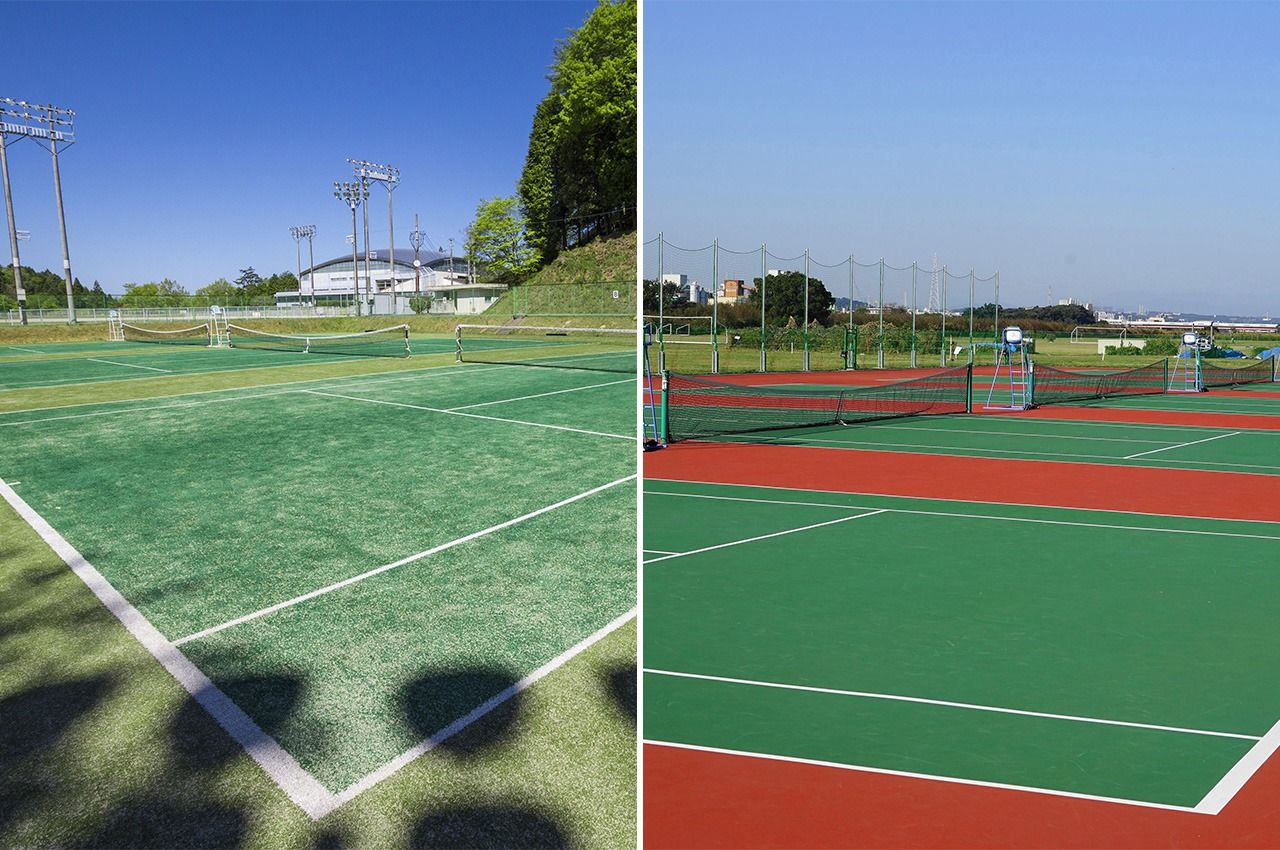
A sand-infused artificial turf court (left) compared to a hard court. (© Pixta)
Comeback Prompts Questions
The carpet courts—with artificial turf overlaid with sand—used widely in Japan were first conceived in Australia, with the sand thought to improve rebound and absorbency. They were then introduced into the country via governing body Tennis Australia and were first used in 1985 at the Summer Universiade in Kobe. Suited to humid and rainy climates and cheap and easy to maintain, these courts now account for nearly half of the domestic market.
After announcing her retirement at the age of 26, Date took a break from tennis, but asserts she remained concerned about the prevalence of sand and artificial turf courts. The Issue became impossible to ignore when staging her comeback a decade later in 2008.
“When I started competing again in lower level competitions sanctioned by the Japanese International Tennis Federation, the events almost always took place on carpet courts,” Date recounts. “It was troubling.”
Unsuitable for the Today’s Game
Date says that since the 90s, the women’s game has shifted to a more powerful style of play. “You get a high bounce with hard courts and clay courts, allowing players to really smash high balls,” she explains. “To compensate, players will sometimes use slice serves to keep the ball low, or otherwise make it hard to predict how the ball will rebound. I would compensate for my lack of power by returning shots immediately off the bounce to take time away from my opponent setting up their swing.”
It was Date’s ability to use the ball’s propensity to bounce high off hard surfaces to her advantage by hitting it on the rise, thereby returning serves without expending as much energy, that helped make her a world-class player. She made it to the semifinals of the Australian Open, US Open, and Wimbledon as well as appeared twice in the quarterfinals of the US Open with her attacking style that enabled her to hold her own against players with more power and better technique.
Tennis balls do not bounce well on sand-dressed artificial turf, though, and players must hit the ball from below to lift it over the net. This forces players to take a defensive style, in which they return shots while waiting for their opponent to make a mistake, rather than an aggressive style of actively trying to score winners.
Date also notes that there is also an increased risk of injury with the surface. “Unlike with clay courts, sand and artificial turf causes your feet to slide unevenly, and if you misjudge an angle, you can easily sprain your ankle,” she warns. She admits that hard surfaces come with their own risks, such as scrapes and friction burns from falling, but insists that players need to be able to play on grass, clay, and hard courts as they are all used in international competitions. “Learning the game on carpet courts is of no merit to a person who plans to compete overseas.”
Behind the Times
Australia, the country that devised and developed this unusual style of surface, deemed it unsuitable for training a few years after its introduction and started replacing it with hard or clay courts. These days, carpet courts like those in Japan are rare overseas, making the surface almost a Japanese phenomenon. Date sees this as a pressing problem and is calling for Japan to adopt courts that comply with international standards to enable athletes to train and compete at the highest level.
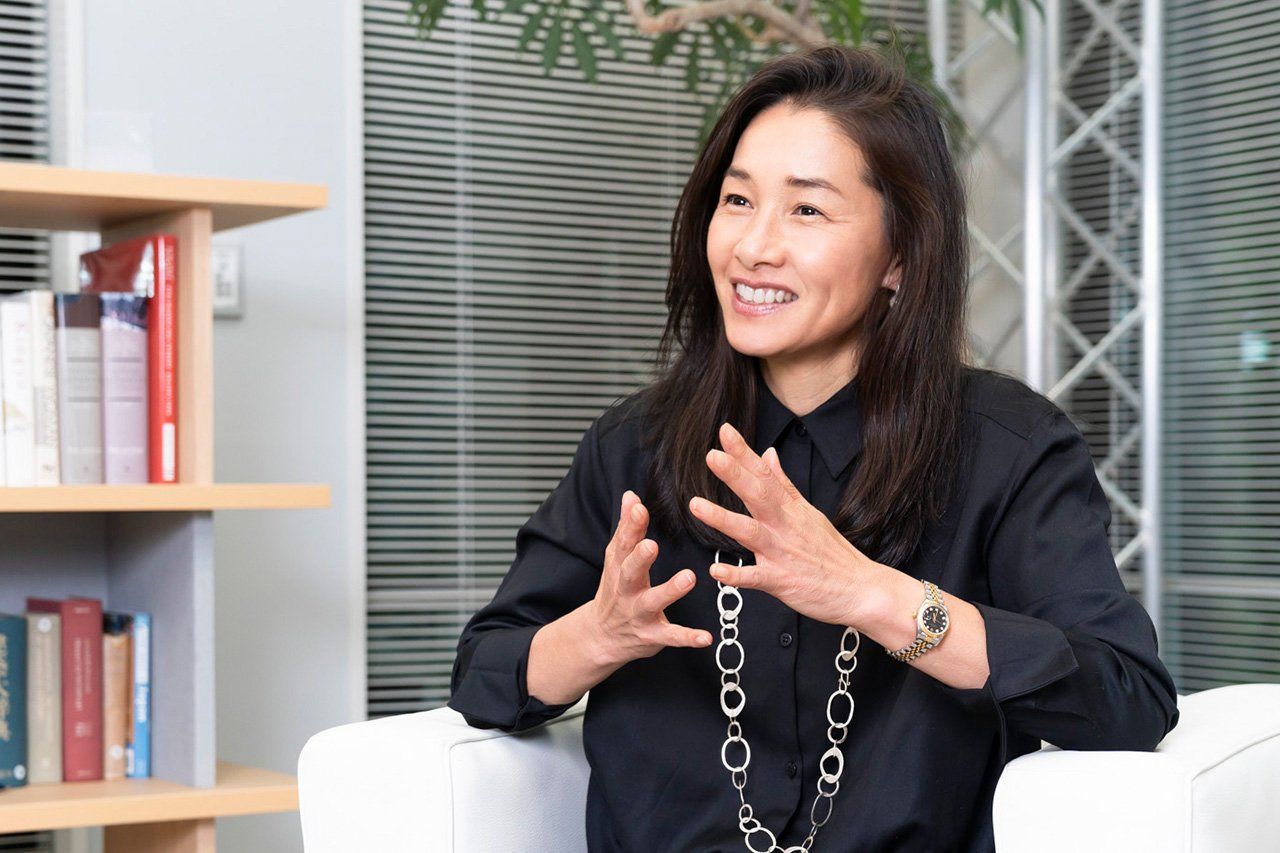
Former Japanese tennis star Date Kimiko. (© Uwadaira Tsunebumi)
Asked why the courts were so warmly embraced in Japan, Date can only offer a shrug. “I suppose Japan’s high rainfall made the lower cost of maintaining sand-treated artificial turf more attractive than a surface like clay,” she suggests. “There are also strong biases when it comes to the surface.”
The popularity of tennis in Japan grew in the 1990s as fans watched Date and several of her Japanese contemporaries battle it out on the world circuit. The number of people taking up the sport increased as did the number of tennis facilities. Public courts available to rent by the hour tend to be used by older players, and the Japan Tennis Association, seeing the tennis boom as an opportunity to promote carpet courts, approved the use of sand-dressed artificial turf, which they said put less strain on the body, was more rain resistant, easier to install, and cost less to maintain.
Painful Truth
Date argues that with regard to injuries, sand and artificial turf courts do not live up to their reputation for safety. “When you talk about playing surfaces, local government will always tell you that carpet courts are easier on the body, but there is no basis for this belief. The old-fashioned hard courts were hard and fast, but modern hard courts are covered by many layers of paint, so they are not as tough on players as they used to be.”
She cites a story about Nishikori Kei falling over and getting hurt while playing on a carpet court while in elementary school as fueling his dislike of the surface.
She notes that a similar bias exists concerning cost. While carpet courts are supposed to be maintained regularly, there is a tendency for facilities to merely apply extra sand to reduce the need for upkeep. Date says that when factoring in installation and maintenance, hard courts may actually be cheaper. “You get the feeling that the arguments against hard courts are based on preconceived notions rather than actual evidence.”
After making her tennis comeback, Date at the age of 40 worked her way up to forty-third in the world rankings. At 42, she made it as far as the third round at the Australian open and Wimbledon. After retiring for good at 46, she turned her attention to righting misconceptions and wrong assumptions about playing surfaces.
She researched the topic at Waseda University’s Graduate School of Sport Sciences, writing her master’s thesis about the fact that Japanese tennis players are being prevented from competing at an international level by outdated court surfaces, basing the paper on a survey of 6,000 people she conducted in Japan in 2018. Her dissertation, which undertakes a detailed analysis of the unusual tennis court surface from a variety of perspectives, was selected as the best thesis published in the School of Sport Sciences that year.
Post-Olympic Slide?
Date has had success in getting carpet courts converted to hard courts. The court at Gifu’s Nagaragawa Tennis Plaza, home of the Kangaroo Cup, the first tournament Date played in after returning to professional competition, used to be covered in sand-dressed artificial turf. However, after Date talked directly to Gifu Governor Furuta Hajime about the issue, the surface was replaced by a hard court, which remains there today.
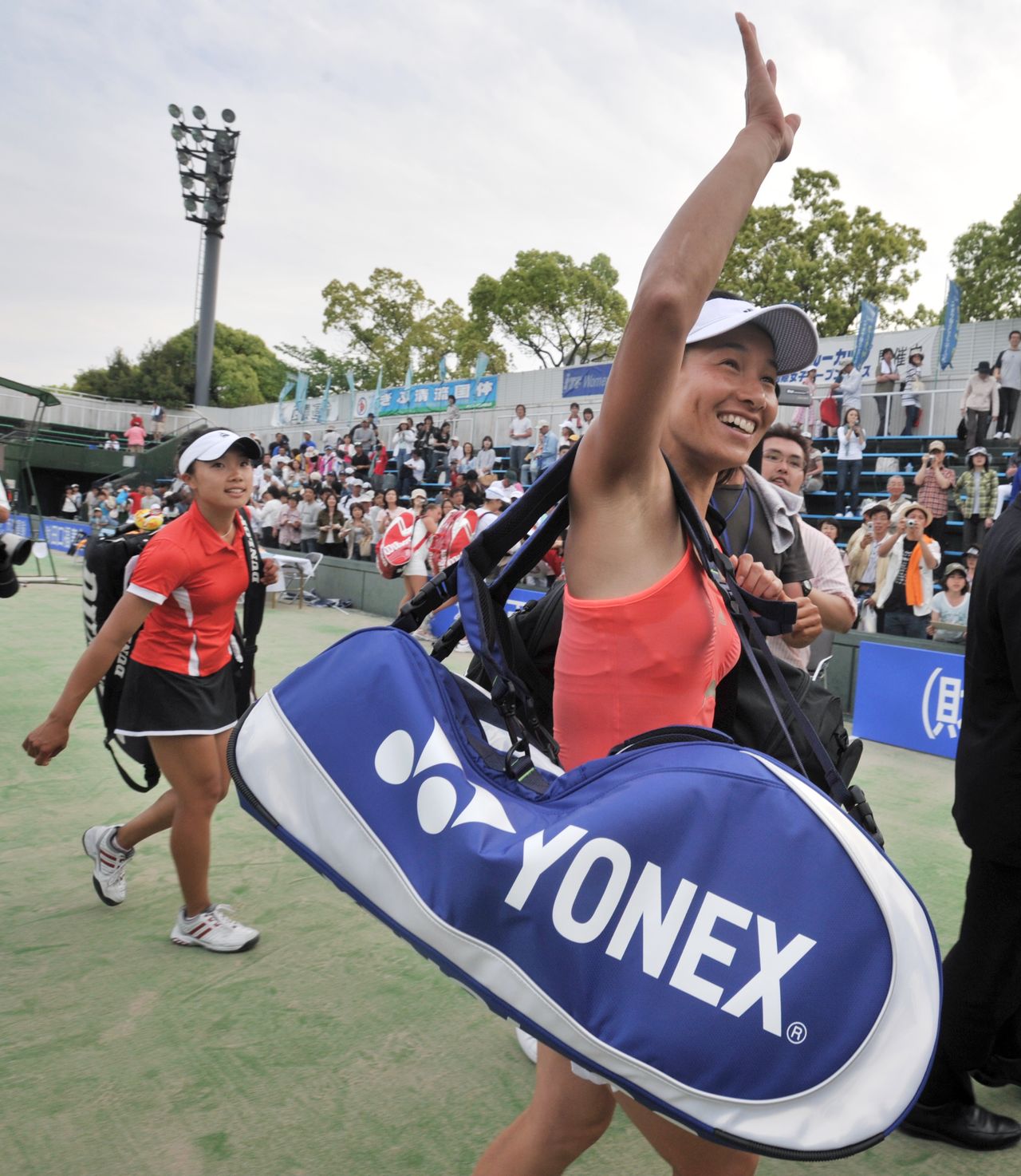
Date waves to the crowd after winning the doubles trophy of the Kangaroo Cup with Nara Kurumi (rear left) on May 4, 2008, at the Tennis Plaza in Gifu, which at the time had carpet courts. (© Jiji)
Carpet courts enjoy steadfast support from members of the tennis community, though. For example, the 16 sand-dressed artificial turf courts in the Ariake Tennis Park, the venue for the tennis events at the Tokyo Olympics, were converted to hard courts, but are scheduled to return to artificial turf after the games. Players who use the facilities demanded the change, and when faced with pressure from paying customers, local bodies tend to go along.
Returning Japan to the Global Standard
It is in this way that Japanese tennis has remained an outlier, although there are signs the situation is changing. Carpet courts are no longer used for university tournaments, with most major events being held on hard courts, and schools like Waseda, Keiō, and Asia University that boast strong tennis teams have also renounced the surface. Waseda graduate Aoyama Shūko, who as of May 17 was ranked thirteenth in the world in women’s doubles, can be held up as an example of a successful player trained on such courts.
“The fact that universities have converted to hard courts is significant, but tournaments for high school students and junior players still use the old courts,” Date declares. “The prevalence of carpet courts at the high school level, when a players’ style becomes defined, is a real disadvantage in terms of training. This issue involves not only the Tennis Association but also the All Japan High School Athletic Federation, so reform does present challenges, but I believe that changing courts will point high school tennis in the right direction.”
So how does Date intend to change tennis court design? “In Japan, the national championships were the catalyst for the progressive adoption of carpet courts over a period of thirty years,” she says. “I believe the quickest approach is to spend another thirty years converting all those courts back to hard courts again at such times as they host major tournaments.” Date insists that success will require winning the support and enthusiasm of local tennis communities. “I’ve taken up the banner because if no one takes action, nothing will change. My aim is to get as many people on board as I can.”
The task of reforming Japan’s tennis courts, isolated as they are from the rest of the world, may seem daunting, but Date’s 30 year timeline seems achievable. After all, it was her own professional success some three decades earlier and subsequent growth in interest in tennis that helped propagate the strange surface to begin with. In the same way that Date once perfected the rising shot, she is certain to come up with a clever strategy for winning her next challenge.
(Originally published in Japanese. Banner photo © Uwadaira Tsunebumi.)
